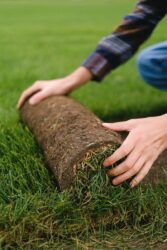Proper fertilization is essential for the health and growth of new Kentucky Bluegrass sod.
Initially, it’s crucial to wait a few weeks until the sod has started to root into the underlying soil.
This allows the new grass to better absorb and utilize the nutrients provided by the fertilizer.
How to Tell If Sod Has Taken Root:
- Tug Test: Gently tug on the sod. If there’s resistance, it’s likely the roots have started to anchor into the soil.
- Visual Inspection: Over time, you’ll notice new growth and a more integrated appearance with the underlying soil, indicating rooting.
- Watering Transition: As the sod takes root, you’ll adjust watering from the initial frequent, light watering to deeper, less frequent sessions, promoting stronger root growth.
Differences Between Sod and Seed Establishment:
- Sod: Provides an instant lawn and root establishment can occur within a few weeks with proper care. The sod should not be fertilized until it has firmly rooted to avoid burning the young roots.
- Seeds: Require germination time and are more vulnerable to environmental conditions initially. Fertilizing too early can disrupt the delicate germination process.
Optimal Fertilization Practices
After ensuring your KBG sod has taken root, typically a few weeks post-installation, apply a starter fertilizer high in phosphorus to encourage root development.
Transition to a regular fertilization schedule, focusing on nitrogen-rich fertilizers, tailored based on a soil test.
Key Fertilization Timelines and Tips
- Initial Fertilization: A few weeks after installation, once the sod has begun to root. Use a starter fertilizer high in phosphorus to promote root growth.
- Regular Maintenance Fertilization: Transition to a nitrogen-rich fertilizer as part of a regular feeding schedule, focusing on early spring, late spring/early summer, and fall applications.
- Fall Fertilization: Particularly crucial for preparing the grass for winter and ensuring a robust return in spring.
FAQs on Fertilizing Kentucky Bluegrass Sod
Q: How soon after laying should you fertilize new Kentucky Bluegrass sod?
A: Wait a few weeks until the sod starts to root into the soil before applying the first round of fertilizer.
Q: What type of fertilizer should be used for new KBG sod?
A: Initially, use a starter fertilizer high in phosphorus. Transition to a nitrogen-rich formula for subsequent applications.
Q: How often should new KBG sod be fertilized?
A: After the initial application, fertilize in early spring, late spring/early summer, and importantly, in fall.
Q: Is it necessary to test the soil before fertilizing new KBG sod?
A: Yes, a soil test can provide insights into the specific nutrient needs and help tailor the fertilization program.
Q: Can over-fertilizing new KBG sod cause damage?
A: Yes, over-fertilization can lead to nutrient burn, stressing or damaging the grass. Follow product guidelines carefully.
In Summary
- Begin fertilization a few weeks after sod installation to allow roots to establish.
- Use a phosphorus-rich starter fertilizer initially, then transition to nitrogen-focused products.
- Maintain a regular fertilization schedule, with particular attention to fall feeding.
Sources and Further Reading
- Nature’s Seed offers guidance on fertilizing new bluegrass lawns, emphasizing the importance of proper nutrient management.
- Sod Solutions highlights best practices for fertilizing new sod, including timing and product selection for optimal lawn health.
- Saratoga Sod provides expert tips on sod care, focusing on the initial steps post-installation to ensure successful sod establishment and growth.



